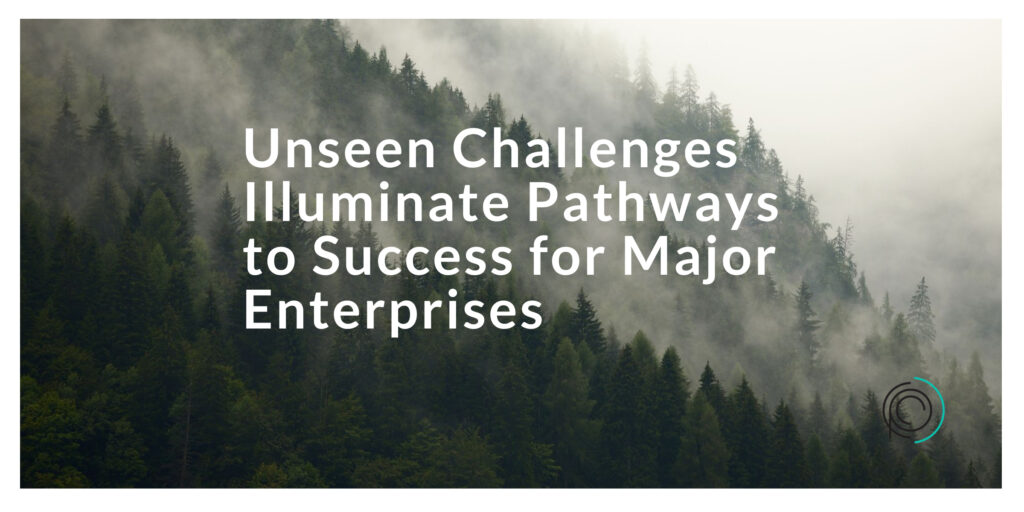Corporate operations ensure the wheels of business run smoothly is a perpetual challenge. For large organizations poised on the brink of mergers and acquisitions, identifying and addressing blind spots is critical. These unseen challenges can make or break strategic initiatives, impacting everything from financial health to market competitiveness.
This blog dives into the intricacies of recognizing and overcoming these blind spots. We will explore how they manifest in large organizations, why they often go unnoticed, and effective strategies to mitigate their impact. By the end of this article, you’ll gain a clearer perspective on maintaining robust business operations and strategic foresight.
The Nature of Blind Spots in Business
Blind spots in business are often invisible barriers that impede the organization’s progress. They can arise from outdated processes, insufficient data insights, or cultural misalignments. These blind spots can often go unnoticed until they manifest as significant disruptions, making it crucial for businesses to proactively identify them.
In large enterprises, the complexity and scale of operations can easily obscure problem areas. This obscurity results from multiple layers of management, diverse teams, and sprawling global operations. Consequently, these blind spots may hinder decision-making, stifle innovation, and result in missed opportunities.
Understanding the nature of these blind spots involves recognizing their potential sources. For instance, a Fortune 100 company might rely heavily on legacy systems, which can limit data integration and slow down decision-making processes. Similarly, cultural blind spots can arise when there is a disconnect between corporate values and employee engagement, leading to decreased productivity.
Recognizing the Consequences of Blind Spots
The repercussions of unchecked blind spots can be significant. They can result in operational inefficiencies, financial losses, and even reputational damage. When business leaders fail to recognize these hidden issues, they risk making uninformed decisions that may not align with the company’s overarching goals.
For example, a merger or acquisition can be derailed by failing to acknowledge cultural differences between entities. Misalignment in corporate cultures can lead to a lack of cohesion, employee dissatisfaction, and hindered integration efforts. Additionally, overlooking market trends or customer preferences can result in missed opportunities for growth and innovation.
The consequences are not just limited to internal operations. Blind spots can also affect external relationships, such as partnerships and customer interactions. A lack of awareness about changing consumer preferences can lead to outdated product offerings and decreased customer satisfaction.
Identifying Common Business Blind Spots
One of the first steps in addressing blind spots is identifying where they commonly occur. Operational inefficiencies, cultural misalignments, and technological limitations are frequent culprits. Additionally, biases in decision-making processes can contribute to the emergence of blind spots.
Operational inefficiencies often arise from fragmented processes and siloed departments. These issues can lead to duplication of efforts, increased costs, and slower response times. Cultural misalignments, on the other hand, can result from a lack of diversity and inclusion, inconsistent communication, and resistance to change.
Technological limitations can also contribute to blind spots. Outdated systems and inadequate data analytics capabilities may hinder an organization’s ability to gather insights and make informed decisions. Furthermore, cognitive biases in leadership and decision-making processes can cloud judgment and lead to suboptimal choices.
The Role of Data in Uncovering Blind Spots
Data is a powerful tool that can illuminate blind spots in business. By harnessing the right data, organizations can gain valuable insights into their operations, customer behaviour, and market trends. Data-driven decision-making enables companies to identify patterns, detect anomalies, and address potential issues before they escalate.
Implementing advanced analytics and business intelligence tools is crucial for uncovering blind spots. These tools can provide real-time insights into key performance indicators, enabling leaders to make informed decisions. Additionally, data visualization techniques can help present complex data in a more accessible and understandable format, facilitating better communication and collaboration.
However, data alone is not enough. Organizations must also foster a culture of data-driven decision-making. This involves ensuring that employees have the necessary skills and tools to interpret and analyze data effectively. By empowering teams with data, businesses can enhance their ability to identify and address blind spots proactively.
Building a Culture of Openness and Adaptability
Creating a culture that encourages openness and adaptability is essential for addressing blind spots. When employees feel comfortable sharing insights and challenging the status quo, organizations can uncover hidden issues and foster innovation. Leaders play a crucial role in setting the tone for an open and adaptive culture.
To build such a culture, organizations should prioritize transparency and open communication. This involves establishing channels for feedback and encouraging employees to voice their opinions. By creating a safe environment for constructive feedback, businesses can gain valuable insights from their workforce.
Additionally, promoting a growth mindset and a willingness to adapt is vital. Encouraging employees to embrace change and learn from failures fosters a culture of resilience and innovation. Leaders can support this by providing opportunities for skill development and recognizing and rewarding adaptability and creativity.
Engaging Stakeholders for Comprehensive Insight
Engaging stakeholders, both internal and external, is crucial for gaining a comprehensive understanding of potential blind spots. Stakeholders bring diverse perspectives and insights that can shed light on hidden challenges and opportunities. By collaborating with stakeholders, organizations can build a more holistic view of their operations and market landscape.
Internal stakeholders, such as employees and department heads, possess valuable firsthand knowledge of the organization’s inner workings. Encouraging cross-functional collaboration and regular feedback sessions can help surface blind spots and promote alignment across teams. Additionally, involving employees in decision-making processes can foster a sense of ownership and engagement.
External stakeholders, including customers, partners, and industry experts, provide valuable insights into market trends and competitive dynamics. Conducting surveys, interviews, and focus groups with external stakeholders can help identify blind spots related to customer needs and preferences. These insights can inform product development, marketing strategies, and customer experience initiatives.
Leveraging Technology for Enhanced Visibility
Technology plays a pivotal role in enhancing visibility and addressing blind spots. Advanced technologies such as artificial intelligence (AI), machine learning, and automation enable organizations to gather and analyze vast amounts of data, identify patterns, and make data-driven decisions. By leveraging technology, businesses can gain a competitive edge and proactively address blind spots.
AI-powered analytics platforms can provide real-time insights into customer behavior, market trends, and operational performance. These platforms can detect anomalies and deviations from expected patterns, enabling organizations to identify potential blind spots and take corrective actions promptly.
Automation tools can streamline processes and eliminate manual tasks, reducing the risk of errors and inefficiencies. By automating repetitive tasks, organizations can free up resources and focus on strategic initiatives. Additionally, technology-enabled collaboration tools facilitate seamless communication and information sharing, improving visibility across departments and teams.
Cultivating a Learning Organization
A learning organization is one that continuously evolves, adapts, and improves. Cultivating a learning mindset within the organization is essential for identifying and addressing blind spots. By fostering a culture of continuous learning and improvement, businesses can stay agile and responsive to changing market dynamics.
Encouraging employees to pursue professional development opportunities, attend industry conferences, and participate in training programs can enhance their skills and knowledge. This not only benefits individual employees but also strengthens the organization’s overall capabilities.
Leaders should also promote a culture of reflection and learning from past experiences. Encouraging teams to conduct post-project reviews and share lessons learned can help identify blind spots and prevent similar issues in the future. By creating a safe space for experimentation and learning, organizations can foster a culture of innovation and resilience.
Addressing Blind Spots in Strategic Planning
Strategic planning is a critical process for organizations to set their long-term goals and make informed decisions. However, blind spots can hinder the effectiveness of strategic planning if not addressed. Recognizing and addressing blind spots in strategic planning is essential for aligning the organization’s vision with market realities.
One common blind spot in strategic planning is the underestimation of external factors and market disruptions. Organizations must conduct thorough environmental scanning and scenario analysis to anticipate potential challenges and opportunities. This involves analyzing market trends, competitor activities, and regulatory changes to ensure the strategic plan remains relevant and adaptable.
Additionally, involving diverse perspectives and expertise in the strategic planning process can help uncover blind spots. Cross-functional teams and input from external advisors can provide fresh insights and challenge assumptions. Organizations should also regularly review and update their strategic plans to reflect changing market conditions and emerging opportunities.
Measuring Success and Continuous Improvement
Addressing blind spots is an ongoing process that requires continuous monitoring and improvement. Measuring success and evaluating the effectiveness of actions taken to address blind spots is crucial for ensuring long-term success. Organizations should establish key performance indicators (KPIs) and metrics to track progress and identify areas for improvement.
Regular performance reviews and data analysis can help identify blind spots that may have emerged after initial interventions. By analyzing data and feedback from stakeholders, organizations can make data-driven decisions and refine their strategies. This iterative approach ensures that blind spots are addressed proactively and that the organization remains agile in a dynamic business environment.
Furthermore, organizations should encourage a culture of continuous improvement and innovation. By fostering a mindset of curiosity and exploration, businesses can identify new blind spots and adapt their strategies accordingly. Encouraging employees to experiment, take calculated risks, and learn from failures can drive innovation and prevent stagnation.
Conclusion
Identifying and addressing blind spots is crucial for corporations navigating the complexities of the business landscape. By understanding the nature of blind spots, recognizing their consequences, and implementing strategies to address them, organizations can enhance their resilience, competitiveness, and long-term success.
Through data-driven decision-making, fostering a culture of openness and adaptability, engaging stakeholders, leveraging technology, and cultivating a learning organization, businesses can proactively identify and address blind spots. By continuously measuring success, refining strategies, and promoting a culture of continuous improvement, organizations can stay ahead of the curve and achieve sustainable growth.
Remember, blind spots are not insurmountable obstacles but opportunities for growth and transformation. By shining a light on these hidden challenges, businesses can unlock their full potential and thrive in an ever-evolving business landscape. To get started, connect with one of our experts today.







